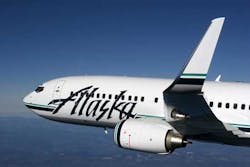The International Council on Clean Transportation, a nonprofit environmental consulting firm funded by Climate Works and the Hewlett Foundation, released its ranking for the most fuel efficient airlines, with Alaska Air Group topping the list as the most fuel efficient.
Alaska Air Group flies mostly newer Boeing 737 jets and Bombardier turboprops at Horizon Air, its regional operation. The airline’s network also is largely composed of flights to and from its hubs in Seattle and Portland, Ore., which limits the “circuity” of its flying.
Allegiant Travel, the ultra-low-cost airline which flies primarily McDonnell-Douglas MD-80s. A heavy mix of MD-80s also weighed on the rankings for American, next-to-last at 14th, and Delta Airlines, 11th. The former Continental Airlines, which merged with United in 2011, was the top network airline for fuel efficiency in 2010, in fourth place.
The rankings include the major carriers’ regional operations, which have assumed a greater portion of the flying at many airlines in recent years. In terms of fuel efficiency, the study found a 26 percent difference between Alaska and Allegiant. “This gap is larger than what might be expected in a mature aviation market during a period of high fuel prices,” the report’s authors wrote.
About one-third of the variation was attributable to airlines with newer fleets—Alaska, Spirit, Continental—and the rest due to a mix of factors including route circuity, airport congestion, differing average percentages of occupied seats, and fuel-saving operating practices such as taxiing with only one engine. Even with its last-place position, “Allegiant actually does a number of things right,” said Dan Rutherford, a co-author of the study. “They had the highest load factor in 2010 and they fly the most direct routes.”
The rankings are based on fuel consumption data reported by airlines to the Bureau of Transportation Statistics, along with a methodology developed by the National Center of Excellence for Aviation Operations Research at the University of California, Berkeley, which took into account airlines’ relative flight distances in miles and their access—in terms of the number of airports served and flight frequencies—to allow for “a precise distinction between fuel burned to provide a given level of service and fuel burned as a result of inefficiencies.”



